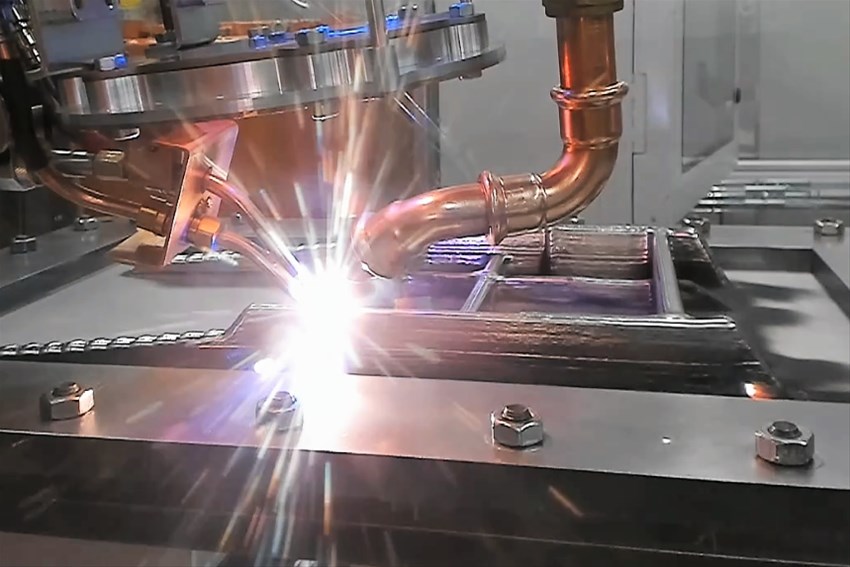Research advances broaden the usage of additive manufacturing
03 Oct 2022
In just four years, researchers at University West have developed additive manufacturing with laser and wire for a completely new material: duplex stainless steel. The technology has been successfully tested for manufacturing of a component to Alfa Laval. Within a few years, the technology could be ready for actual industrial production.

Within a few years, additive manufacturing with laser and wire for duplex stainless steel could be ready for actual industrial production. Photo: Procada
The benefits and opportunities of Additive Manufacturing (AM) are vast and numerous. The technology is seen as an important part of the next generation of industrial production, where sustainability requirements are high. Different variants of the technology are already in use in certain product areas and industries. But each new application requires extensive research to develop and adapt the technology to different materials, ensuring that quality requirements are met.
‘Our scientists have more than 15 years of experience in AM with laser and wire. This has enabled us to develop the technology for duplex stainless steel in a relatively short time. Today, expensive forgings are often used in the manufacture of high-performance components such as aircraft engine parts. In addition, the lead time for this type of material is often long,’ explains Robert Pederson, professor in materials technology.
Significantly shorter production time
‘Additive manufacturing offers more efficient use of materials, lower energy consumption, and shorter lead times compared to traditional forging manufacturing methods, which require extensive machining.’
‘Our test with one of Alfa Laval's components shows that production time can be reduced from 20 weeks to just 2 weeks. Scaling up the AM process for serial production of two of their parts has the potential to save around 170 tonnes of material per year. This is equivalent to 170,000 kg of CO2 emissions.’
‘If the technology proves fully viable for serial production with these two components, there is potential to expand with more of the company's parts,’ Robert notes.
For AM with laser and wire to succeed, the entire manufacturing process must be automated, robust and reliable. Subsequently, one important task for the project team has been to develop and build an automatic production system with closed loop control. In the summer of 2019, the team were able to do this for a scaled-down detail, making them among the first in the world to use such a solution.
Valuable collaboration
The project team has also developed an advanced simulation model that provides increased process understanding by showing how different process parameters affect material quality.
‘GKN Aerospace has helped us to conduct validation experiments with titanium to validate the model for that material. The development of simulation models overlaps several different areas of expertise within the project, and this approach has proven to be a strength in our work.’
The research, funded by the Knowledge Foundation, has been carried out in close collaboration with industrial companies Alfa Laval, GKN Aerospace, Permanova and ITW Welding. All have brought different skills and interests to the project. In addition, consultancy company Procada was involved in the production of the demonstrator, which was used in the test run.
‘For us, both the expected cost reduction and the reduced CO2 footprint of the material savings are of course very welcome,’ says Andreas Bergman, Program Manager, Alfa Laval.
‘When you then consider the potential to reduce capital that is tied up as a result of having to maintain inventory due to long and uncertain lead times, we think we’re on to a real winner.’
Research continues in new projects
Further research and development is required to make the technology useful for industries producing duplex stainless steel products. In September, the university's AM researchers started work on 3-year Vinnova-funded project SESAM, in which certain technical parts of AM with laser and wire will be developed to ready the technology for serial production.
This autumn will also see the start of an 8-year cutting-edge research project, DEDICATE, in which University West will further develop additive manufacturing with wire and powder for Ni-based metals, titanium, aluminium and steel.
‘Eleven companies are participating in the project, all with different interests and roles in our research work. There are end-users in a range of industries, including GKN Aerospace, BAE Systems Hägglunds, Volvo Trucks, Esab and Alfa Laval,’ says Robert.
Accelerating AM research
‘The aim is to build on the competence that University West already has in additive manufacturing, and to further profile our research. For many years, we have been purposefully accelerating our AM research by moving from several minor projects to a smaller number of major research initiatives.’
In parallel with DEDICATE, another 8-year AM project, PODFAM, is underway, focussing on powder-based AM.
‘These two major cutting-edge research projects can be seen as the "core engines" of our AM research. We are linking several smaller AM research projects to them, to maximise the synergy effects. But ultimately, it's about strengthening the competitiveness of Swedish industry,’ says Robert.
Contact: Robert Pederson, professor in materials technology, University West.


